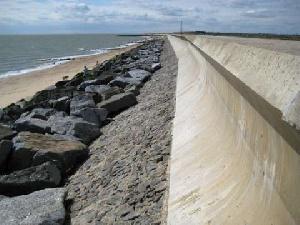- Home
Sea Defense Walls as a Climate Change Adaptation Measure?- The case of Ghana Institute of Green Growth Solutions
July 14, 2025
Ghana is combating climate change along its vulnerable coastline by constructing sea defense walls—a critical adaptation strategy to protect coastal communities from rising sea levels, erosion, flooding, and storm surges, all exacerbated by climate change.
The Challenge
A few questions arise: How much will it cost to provide defense walls for all vulnerable communities along the coast of Ghana? Is this the best climate change adaptation approach to sea level rise?
The Projects
These projects are part of Ghana’s National Climate Change Adaptation Strategy and Coastal Development Framework, supported by government agencies like the Ministry of Works and Housing and international partners such as the World Bank and UNDP.
Combined with nature-based solutions like mangrove restoration and sustainable coastal management, sea defense walls have delivered significant benefits, including:
-
Protecting homes, farmlands, and critical infrastructure
-
Safeguarding fishing and tourism industries
-
Enabling land reclamation in some areas
Key Sea Defense Projects in Ghana include but not limited to:
-
Keta Sea Defense Project (Volta Region)
One of Ghana’s earliest responses to coastal erosion, this multi-phase project (since the early 2000s) protects Keta, Vodza, Kedzi, and nearby towns from tidal waves and erosion. It features sea walls, rock barriers, and land reclamation, reducing displacement and shielding roads, schools, and other infrastructure. It cost approximately US$155m. -
Ada Sea Defense Project (Greater Accra Region)
Designed to halt erosion in Ada Foah, this project uses rock revetments to redirect wave energy and trap sand, protecting settlements and resort areas. It was completed at a total cost of 225 million Euros. -
The Anomabo Sea Defense Project in the Central Region (US $79.9m) and the Aboadze Sea Defense Project in the Western Region (US $28.5 million) were constructed to safeguard fishing communities and energy infrastructure from rising seas and severe coastal degradation.
-
Executed in two phases at a total cost of US$60m, the Sakumono Sea Defence Project was undertaken to protect infrastructure – the Asaprochona–Tema rail line, the Nungua–Tema beach road, shield the Maritime University and the Sakumono/Nungua community.
-
The Nkontompo Sea Defence project, undertaken at a cost of US$23m was designed to shield the coastal communities and infrastructure (homes, fish landing sites) of Nkontompo, Poasi and New Takoradi in the Western Region from wave impact and to improve and expand safer, larger fish landing facilities for local fishers.
-
Community-Integrated Projects (James Town, Moree, Elmina, Teshie, Mumford, etc)
Beyond erosion control, these initiatives include livelihood restoration, such as fish landing sites and beach access paths. Community consultations ensure local buy-in and climate awareness. -
Other sea defense projects have also been undertaken at Cape Coast (approximately US$50m), Komenda (US$46m), and Dansoman (US$31.2m)
A Multi-Faceted Approach to Resilience
For local communities who are impacted by floods and sea level rise, the Climate Vulnerable Forum will be working with the Global Shield Solutions Platform to provide insurance for selected communities in the Greater Accra Metropolitan Area. Success stories and lessons learnt could be replicated in other areas of the country. Ghana’s sea defense walls serve as a frontline defense against climate change, protecting lives, economies, and ecosystems. By blending engineering, policy, community engagement, and environmental restoration, Ghana is fortifying its coastline—one wall at a time.

-
July 14, 2025
-
June 5, 2025
-
March 22, 2025
-
March 21, 2025
-
March 20, 2025
-
Oct. 1, 2025
6 a.m. - 6 p.m. -
Aug. 28, 2019
9 a.m. - 5 p.m. -
Aug. 23, 2018
8:30 a.m. -
Oct. 31, 2017
9 a.m. - 3 p.m. -
March 17, 2017
10 a.m. - 3 p.m.



